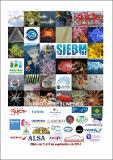Por favor, use este identificador para citar o enlazar a este item:
http://hdl.handle.net/10261/320491COMPARTIR / EXPORTAR:
 SHARE
BASE SHARE
BASE
|
|
| Visualizar otros formatos: MARC | Dublin Core | RDF | ORE | MODS | METS | DIDL | DATACITE | |

| Título: | Polychaete assemblages from mud volcanoes and adjacent bottoms of the Gulf of Cádiz |
Otros títulos: | Asociaciones de poliquetos de volcanes de fango y fondos adyacentes del Golfo de Cádiz | Autor: | Rueda, José Luis; Moreira, Juan; López-Díaz, Eduardo; San-Martín, Guillermo; Salas, Carmen; González-García, Emilio; Marina-Ureña, Pablo; Urra, Javier; Fernández-Salas, L.M. CSIC ORCID ; López-González, Nieves CSIC ORCID; Díaz-del-Río-Español, Víctor; Gallardo-Núñez, Marina | Palabras clave: | Medio Marino Centro Oceanográfico de Málaga Poliquetos volcán de fango surgencias frías Batial Golfo de Cádiz |
Fecha de publicación: | sep-2014 | Editor: | CSIC - Instituto Español de Oceanografía (IEO) | Citación: | XVIII Simposio Ibérico de Estudios de Biología Marina. Libro de resúmenes.. Ríos, P. (Pilar); Suárez-Fernández, L.Á. (Luis Ángel); Cristobo, J. (Javier) (ed.). Centro Oceanográfico de Gijón (Instituto Español de Oceanografía). Gijón (España). 2014. 2 pp: 110-111 | Resumen: | The Gulf of Cádiz represents an area of extensive seepage activity in the Atlantic Ocean, with the presence of ca. 50 mud volcanoes located in Spanish, Portuguese and Moroccan waters (200-4000 m depth). Recent studies have revealed the presence of a wide variety of habitats and species due to the heterogeneous characteristics of these cold seeps and of the seabed of the Gulf of Cádiz where different geological processes, water masses and substrate types occur. Information on some components of these bathyal benthic communities (e.g. polychaetes) is very scarce, especially for those mud volcanoes located in Spanish waters of the Gulf of Cádiz. In order to study the polychaetes assemblages, samples were collected in different areas (summit, flanks, depression, adjacent bottoms) of ten mud volcanoes located within Spanish waters (300-1100 m depth), during the INDEMARES/CHICA 0610, 0211 and 0412 surveys. Sampling was carried out using different methods such as box-corer (BC) (ca. 0.09 m2 of sampling area, n=82), benthic dredge (DA) (ca. 300 m2, n=56) and beam-trawl (BT) (ca. 2000 m2, n=40) on board R/V Emma Bardan, Cornide de Saavedra and Ramón Margalef. Sediments collected with the box-corer were sectioned at 5 cm intervals and sieved (0.5 mm) in order to study the vertical distribution of polychaetes. Material collected with the benthic dredge was sieved on a sieve column of 10, 5 and 1 mm mesh sizes. Sedimentological (Eh, grain size distribution, organic matter content) and water column (temperature, salinity, current speed) features were measured in order to characterize the environment where the different species occur. A total of 115 spp. have been found in the material collected, with the "Sedentaria" taxa represented by more species (ca. 60%) and individuals (ca. 80 %) than the "Errantia". The best represented families were Serpulidae (12 spp.), Sabellidae (7 spp.), Spionidae (6 spp.), Maldanidae (6 spp.), Eunicidae (5 spp.), Onuphidae (5 spp.) and Glyceridae (5 spp.). Some species were only collected in beam-trawl samples or benthic dredges (e.g. Hyalinoecia tubicola, Aphrodita alta, Haplosyllis spongicola) and others in box-corer samples (e.g. Spiophanes kroeyeri, Chone longiseta, Gesaia elegans, Poecilochaetus fauchaldi, Pherusa flabellata). This suggests that the combination of different sampling methods is needed to document more accurately the polychaete biodiversity in these habitats. New records for the area or at this depth range are Tetreres varians, Pherusa flabellata, Glycerella magellanica, Subadyte pellucida (associated with Leptometra phalangium) and Ophelia radiata, among others. Frenulate polychaetes (Siboglinidae) were the top dominant group, particularly at the summit of some MV. These thread-like worms occurred in anoxic reduced sediments, displaying their highest densities in Hespérides and Aveiro (> 1000 indiv. m-2) and the lowest (< 100 indiv. m-2) in Gazul, Pipoca and Tarsis. Non-chemosymbiotic polychaetes such as maldanids (Euclymene santanderensis), paraonids (Aricidea assimilis, Tauberia gracilis) and chaetopterids (Phyllochaetopterus socialis) also occurred in these reduced sediments. In sedimentary habitats, such as those with sea-pen communities, bamboo corals or hexactinellids (Pheronema carpenteri), the assemblage was dominated by Aglaophamus pulcher, Paradiopatra hispanica, Hyalinoecia tubicola, Eunice vittata and Fimbriosthenelais cf. zetlandica, among other species. In hard bottoms with authigenic carbonates, serpulids were numerically dominant components, especially Filograna implexa, Serpula vermicularis and Vermiliopsis infundibulum, together with some mobile species (e.g. Phyllodoce cf. maderensis). In hard bottoms with cold water corals, Eunice norvegica and Glycerella magellanica were found inside live and dead coral colonies, respectively. Polychaete assemblages of mud volcanoes with hard bottoms or mixed bottoms (Gazul) displayed the highest numbers of species in relation to those of adjacent bottoms or of mud volcanoes with soft bottoms and high densities of siboglinids (Hespérides, Aveiro). | URI: | http://hdl.handle.net/10261/320491 |
| Aparece en las colecciones: | (IEO) Libros y partes de libros |
Ficheros en este ítem:
| Fichero | Descripción | Tamaño | Formato | |
|---|---|---|---|---|
| Rueda et al_2014_Polychaete assambleges from mud volcanoes and adjacent bottoms of the gulf of Cádiz_libro resumenes_SIEBM2014.pdf | 440,14 kB | Adobe PDF |  Visualizar/Abrir |
CORE Recommender
Este item está licenciado bajo una Licencia Creative Commons

